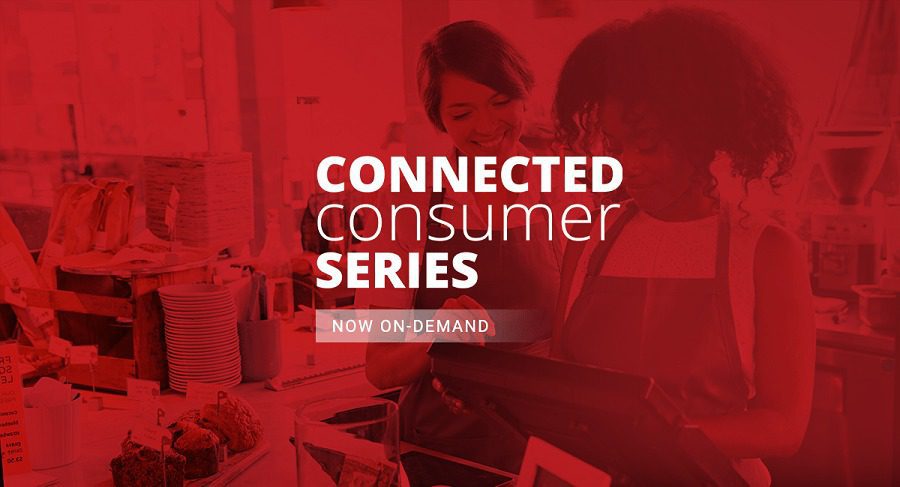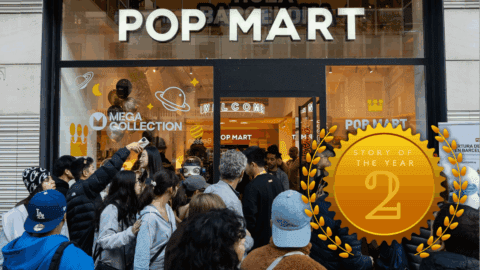Every year, the Connected Consumer Series digital event brings together some of the retail industry’s top analysts, tech experts and industry thought leaders. In addition to spotlighting ways retailers can embrace cutting-edge trends and technologies, this year’s event focused on helping retailers adapt to the new reality of the coronavirus pandemic.
As the industry actively monitors and responds to new developments surrounding COVID-19, business leaders must determine not only how they’ll respond today, but how they should refine their business strategies moving forward. This year’s sessions provided timely commentary on how the pandemic may impact — even accelerate — the adoption of new technologies and experiences, and how retailers can keep pace. Topics included:
- Digital personalization and individualization;
- AI and social messaging;
- Intelligent virtual agents;
- Subscription services and relationship commerce;
- Platform integration to improve e-Commerce experiences; and
- Digital workforce
training and empowerment.
In addition to practical insights and relevant data, sessions featured real-world retail success stories from brands such as Fabletics, GNC, LaCrosse Footwear, The Home Depot and more.
The Path to Individualization: Improving The ROI From Your Personalization Investment
Personalization presents retailers with a moving target: not only does every shopper have different preferences and expectations, but both these factors continue to change on both the personal and cultural levels. This means many retailers struggle even with the “basics” of defining a roadmap or getting personalization programs off the ground.
Erin McElwee, Senior Digital Consultant, and Mike Davidson, Executive Creative Director at the Capgemini Digital Customer Experience Practice, laid out the three pillars of personalization: Organization, Experience and Technology. However, none of these pillars will work alone; each must complement the others to create a cohesive personalization strategy:
- Organization and Experience: Do we have the skill sets to deliver successful personalization?
- Experience and Technology: Can we create a granular picture and profile data of the customer?; and
- Technology and Organization: Is our customer data reliable and accurate?
Listen to the session on-demand.
Using Intelligent Virtual Agents To Solve Customer Support Challenges
Shoppers are becoming more comfortable with virtual assistant technology, and it’s having a profound impact on their retail expectations: Gartner projects that 85% of customer interactions will start with self-service by 2022. The market for virtual assistant technology, the entry point for much of modern self-service shopping, is doubling annually, according to Callan Schebella, CEO of Inference Solutions.
“We have now passed the tipping point where self-service is the preferred form of service,” said Schebella. “If we went back just a couple of years we wouldn’t really be able to say that.”
Retailers can simultaneously meet shopper expectations and streamline operations using Intelligent Virtual Agents (IVAs), which automate customer interactions across multiple channels. The technology’s capabilities include:
- Enabling product research and purchasing via phone and messaging;
- Quickly connecting shoppers to the live agents best equipped to help them;
- Cutting service costs by up to 90%;
- Simplifying the management of phone systems across store networks; and
- Automating buy online, pick up in-store (BOPIS) offerings — a powerful tool in a post-social distancing world.
Listen to the session on-demand.
How The Rise Of AI And Social Messaging Has Driven Seamless Retail Experiences
This session revisits a conversation held between Alexandra Mack, Solutions Product Marketing Leader at Zendesk, and John Glasgow, Director of Commerce Strategy at Adobe and Magento Commerce Cloud, which covered the increasing adoption of self-service content, the need for personalization across all five stages of the customer journey and growing opportunities for AI within retail.
As many as 69% of customers want to resolve most issues on their own, yet only 20% of retailers actually offer some form of self-service, Mack shared. Self-service examples include offering an easily searchable help center with articles that answer questions related to products, the web site and other pre- and post-purchase logistics.
The presentation also included a case study from LaCrosse Footwear, revealing that AI-based live chat and social are the fastest-growing customer service channels for the brand. Phil Schneider, Customer Service Manager of LaCrosse Footwear, noted that use of these channels led to an increase in agent productivity (measured by number of monthly solved support interactions) and a decrease in call volume.
Listen to the session on-demand.
IPaaS: E-Commerce Integrations For Efficiency, Reliability And Driving Customer Experience
With COVID-19 pushing consumers to shop online for their non-essential needs, it’s time for retailers to adapt their e-Commerce buying experiences — particularly if they haven’t yet optimized them across the enterprise. The change in the e-Commerce landscape since the outbreak has resulted in a shift in product demand and more delivery delays, forcing retailers to gain better control of both the pre-checkout and post-checkout ends of the buyer experience.
In this session, Celigo execs Ebru Saglam and Mark Simon discussed the importance of platform integration as a way to enhance visibility to customer and order data across systems and channels, as well as automating processes to update this data, which in turn saves time and reduces costly errors. When this “Integrated platform-as-a-service” is implemented correctly, retailers can streamline multiple areas of their e-Commerce business to become more operationally efficient, including marketplaces, ERP, returns management, POS and the storefront.
Listen to the session on-demand.
Uncertainty Demands Increased Operational Flexibility Through Cloud-Native Technology
Consumer expectations about the real-time availability of accurate, relevant information force retailers, particularly those with legacy IT systems, to play catch-up — and the current COVID-19 crisis is shining a spotlight on the gap. “Mobility and price transparency drive consumer decisions today,” said Brian Kilcourse, Co-Founder of Retail Systems Research (RSR). “And consumers are working in real time, as in ‘now.’ They have the same expectations of retailers’ systems. Today, how does a retailer deal with not knowing exactly how much inventory they have in any given location?”
Retailers can begin to close this gap by adopting cloud-native technology, according to Kevin Swanwick, Senior Director, Retail Solutions at Manhattan Associates. “Properly implemented, cloud technology allows retailers to begin to address challenges such as having real-time information about customers or where inventory is located, along with algorithmic technology that can determine the best way to make the customer happy,” said Swanwick, offering the example of “delivering a product in the time frame the customer wants, but doing it profitably.”
By putting customer-facing and employee-facing applications in the cloud, retailers can push the “right piece of data to people in ways that are contextually appropriate,” said Kilcourse. “That could go to a merchandise manager, an employee filling an order in a store or a customer investigating a product.”
Kilcourse advised retailers that are just starting their move to cloud applications to “pick something that’s important but fairly discrete, such as forecasting, which has changed dramatically in the past few years due to the availability of data and AI-powered solutions to analyze it. Forecasting is something that can be separated from mainstream processes and put up in the cloud.”
Listen to the session on-demand.
Reshaping The Shopping Experience For The Coming Decade
In the wake of the COVID-19 pandemic, a lot has changed in a very brief time when it comes to shopper behavior. But it’s still important for retailers to get a sense of the longer-term picture as far as the technologies and trends shoppers will favor in the upcoming decade. For example, did you know that while 64% of shoppers desire self-checkout kiosks within their in-store shopping experiences, only 48% of retailers think consumers want them?
Art Wittman, Editor of Brainyard at Oracle NetSuite, and Chris Benner, Master Industry Principal at Oracle NetSuite, shared results from a survey of 2,000 consumers and 400 retailer execs, covering findings across in-store shopping, social media and influencers, inventory availability, product reviews and personalization.
Given the current state of affairs, it’s important for retailers to recognize where they need to step up. For example, they appear to be on the same page with shoppers in understanding that they need to deliver personalized experiences, but many haven’t done so yet. As many as 74% of shoppers do not believe retailers are delivering a much more personalized online shopping experience than they were five years ago, while 76% of retailers feel the same way.
Listen to the session on-demand.
From Personalization To Individualization: 5 Ways Brands Are Tailoring Customer Experiences
The RTP editorial team came together to highlight top examples of how retailers are leveraging data to tailor customer experiences in five ways:
- Optimizing fit recommendations (Nike Fit app, Fabletics survey);
- Driving product curation and selection (Pair Eyewear snap-on frames, Half Price Books’ community-based localization);
- Fostering shopper relationships (Muji mobile launch, Vans #VansFamily campaign);
- Improving service and event interactions (Sephora events and courses, Ruti in-store facial recognition); and
- Creating dynamic, curated content (Wayfair idea boards, The Home Depot’s “complete the project” curation for DIY projects).
“More consumers are going to e-Commerce, so brands or retailers are having to shift or reallocate those dollars to digital advertising, digital targeting and engagement,” said Alicia Esposito, Senior Content Strategist, Retail TouchPoints. “Although personalization, digital services and content have always been important, right now we need all of these tactics in order to create these experiences that frankly, your consumers can’t get anywhere else.”
Listen to the session on-demand.
Preparing For Retail’s Return: Ensuring Frontline Associates Are Ready
Training may be low on retailers’ priority lists during the COVID-19 pandemic, but it should actually be near the top, according to Bob Phibbs, CEO of the Retail Doctor, and Carol Leaman, CEO of Axonify. When stores do reopen, “there will have to be a lot of customer engagement and sales to move things back to an even keel,” said Leaman.
Phibbs noted that now more than ever, retail must operate on hope: “You must realize that your employees are no different than your customers — they are your internal customers — and they’re looking for someone to say ‘We’re going to be fine, and I have hope that we can get through this.’ That takes everyone understanding how we’re going to do it, along with guardrails of what we don’t want to do.”
More will be expected of retail employees during the post-pandemic period. “The days of serve-yourself warehouses and unengaged employees who would rather do anything than work retail are going to be gone,” said Phibbs. With unemployment rates high, retailers will have an opportunity to upgrade their staffs.
Both Leaman and Phibbs believe training is most effective when it’s done every day, rather than the typical “one-and-done” style that has been the norm. Effective training also requires support at the highest levels of the organization: “Foot Locker uses the Axonify solution, and both the CEO and the head of the board log into it every day,” said Phibbs. “You know that throughout the organization training is important, because it touches every interaction you have with the customer.”
Listen to the session on-demand.
Retail’s Shrinking Margin For Error: How Top Brands Are Using Next-Level Intelligence To Find New Customers And Improved Bottom Line Performance
Retailers are meeting new challenges and honing existing strategies by using next-level cloud data tools that deliver detailed intelligence focused on customer behavior and desires.
Mark Lawrence, Solutions Director, Analytics and Enterprise at Oracle Retail, shared customer stories and details about how the Oracle Retail Consumer Insights Cloud Services help retailers see data in new ways. Results can include significant reductions in customer acquisition cost as well as a boost in the number of consumers completing purchases.
The tools can be optimized by different business users. Drilling down, for example, some questions that can be addressed by a Buyer include:
- What is driving my omnichannel customer order sales?
- How am I moving my inventory to fulfill orders, and how can that be improved?
- Why are certain suppliers performing better than others?
While a Loyalty Manager could find out:
- How are my products selling across various customer demographics and behavioral attributes?
- How can I exploit the ways my customers leverage available channels?
- What upsell makes sense for various customer segments, so I can send a coupon?
Listen to the session on-demand.
New Realities For The Retail Workforce
At Workforce Insight, Scott Knaul has uncovered a wealth of insights around how successful retailers are managing and optimizing their workforce strategies. But in light of COVID-19, organizations face ongoing uncertainty and must constantly adapt to new guidelines.
“I would say for the most part the retail industry pulled it together quickly and understood what they needed to do in the moment,” Knaul said. “But the biggest question was, What do we do now? How do we operate?”
Now, retailers must adapt their strategies based on whether they’re an essential or non-essential business. For essential retailers, Knaul recommended assessing workforce comfort level, availability, and whether they should be offered hazard pay. He also spotlighted the logistical requirements for onboarding and cross-training employees, especially for essential retailers that are seeing increased demand.
An ongoing theme in Knaul’s presentation was ways retailers can maintain employee trust and engagement, and even support digital purchases. He emphasized the importance of new training opportunities and empowering store associates to do digital clienteling.
Listen to the session on-demand.
Engaging Customers Throughout The Seven Steps Of The Shopper Journey
Retail marketers are familiar with the seven steps of the shopper journey: Inspiration, Awareness, Evaluation, Consideration, Motivation, Conversion and Loyalty. Each one offers opportunities to engage with customers — as well as lose them. Focusing on buyer intent at every step of the journey can improve a retailer’s chances of gaining both an individual transaction and a more loyal customer.
“Retailers should map consumer intent first, and then construct strategies to reach them along every step of that journey,” said Bradley Hearn, who manages content marketing at ChannelAdvisor.
Hearn and his colleague Greg Ives provided advice and “pro tips” for each phase of the shopper journey. In the “Inspiration” phase, brands can “hitch their product to another, better-known product,” said Ives. This can be accomplished with “customers also bought” recommendations, such as offering a cell phone charger and case with the sale of a mobile phone.
For the final “Loyalty” phase, Hearn recommends:
- Updating customers when a package ships, and sending a “thank you” confirmation immediately after a purchase;
- Responding quickly to questions and feedback, both positive and negative;
- Maintaining a consistent and on-brand social presence that followers can share; and
- Personalizing email marketing efforts to be a mix of promotional, informative and rewarding, e.g. with repeat customer incentives.
Listen to the session on-demand.
Pro Tips For Maximizing E-Commerce Subscription Revenue And Customer Loyalty In Uncertain Times
As consumers continue to socially distance, they’re limiting the number of brick-and-mortar trips they take — even for essential items. Retailers across categories have an opportunity to meet shoppers’ immediate needs and boost long-term online revenues, by incorporating subscription services into their commerce strategies.
Brandon Ramos, Chief Customer Officer at Ordergroove, shared tactical best practices to help retailers improve the end-to-end subscription experience. The five key tips to subscription success include:
- Make your subscription program highly visible and easy to enroll in;
- Facilitate trust and convenience;
- Offer much more value than “one and done”;
- Present better upsell and cross-sell experiences; and
- Get ahead of customer churn from day
one.
Applying these tips can help brands and retailers keep pace with Amazon, which has seen significant success with seamless re-ordering and subscriptions, according to Ramos. “Unless you’re building a real customer value chain for current customers, it’s going to be hard to compete if Amazon is going to provide that level of convenience and value.”













